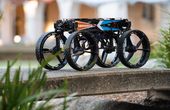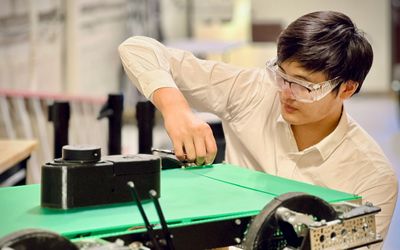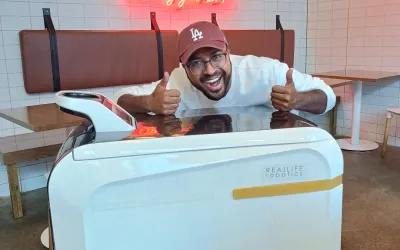Starship Technologies - Starship Robot
A six-wheeled ground robot that can autonomously navigate for delivering packages.
Technical Specifications
| Robot dimensions (without flag) | 697 x 569 x 571 mm |
| Total weight | 35 kg |
| Cargo box dimensions | 400 × 320 × 340 mm |
| Maximum load | 10 kg |
| Maximum speed | 6 km/h |
| Battery size | 1260 Wh |
| Operating time | over 12 hours of driving time |
| Sensors | ultrasonic sensors, 12 cameras, radar, GPS, alarm system, reflectors, time-of-flight cameras, stereo cameras |
| Object Identification Distance | up to 200 feet away |
| Camera FPS | 2,000 frames per second |
Overview
Problem / Solution
A van can produce 181 grams of CO2 emissions on an average delivery. Transportation of goods is likewise an expensive obstacle for large companies, given the cost of the constant flow of goods. It consumes too much time and exhausts employees in sending and receiving orders. On top of that, person-to-person contact is unavoidable and may trigger contamination of goods and the transfer of viruses among employees.
Starship Robots are designed as autonomous robots for Industry 4.0. These robots can transport goods from point A to point B in minutes. With access anytime and anywhere, employees can monitor these robots and can take over control of their autonomous driving features. These robots can carry internal mail, spare parts, samples, and other goods, alleviating employees of time-draining and tiring expensive journeys on company premises. These autonomous robots are now in use at several industrial sites of DAX-listed companies.
Design
With sensors and AI mapping, Starship makes sense of the world around it. The mapping system lets the robot know its location with precision to the nearest inch. The robot travels any path a pedestrian walks, especially sidewalks. The advanced object-detection system at over 2000 fps allows the robot to go up curbs and even operate despite rain and snow.
Weighing 35 kg, Starship can carry up to 10 kg load. It measures 697 x 569 x 571 mm, and packs a cargo box dimension of 400 x 320 x 340 mm. Its 1260 Wh battery approximates a 12hr drive time at a maximum speed of 6 kph. Safety measures include ultrasonic sensors, alarm systems, signal flags, and time-of-flight cameras. It has 12 cameras, radar and GPS, reflectors, and stereo cameras.
Autonomously Travel
The robot’s computer vision and GPS prompt its autonomous travel and location-pointing down to the inch. It detects obstacles using a situational awareness bubble around it. The twelve cameras, mixed with a sensor suite, source information for mapping and detecting cars and traffic lights. Starship foresees objects 200 feet away and makes necessary corrections to avoid things when necessary. It reduces its speed when near an adjacent object not in front of it, and makes a full stop when an object is in front. Operating from sunrise to sunset, the robot has a light on both front and rear, which is seen from all sides during clear weather over a distance of at least 500 feet.
Package
Starship delivers anything that fits inside its container with a size of 400 x 320 x 340 mm, like parcels, groceries, food, medication, and countless more. It has compartments for separating hot and cold food. Securing lock during transport, the lid only opens when prompted by the customer’s mobile app or the company providing service.
Starship Services
With Starship’s advanced mapping, industrial premises are mapped even before the first delivery—excluding hazardous areas in route planning from the start to the loading point.
Employees receive personal training on how to use Starship and how to make and receive deliveries. These pieces of training occur before the autonomous deliveries of the robot. Using a browser-based platform, the recipient and sender can also track deliveries using a computer, tablet, laptop, or mobile phone.
Ensuring safe travel, route planning can identify short-term road closures, instructing the algorithm to find alternate routes in real time. Despite the autonomous travel, customer support is available for handling customer services. Customer support can be reached via email and telephone for any concerns, suggestions, and feedback.
The Starship experience is constantly optimized as experience shows more internal transport demand exists, leading to potential new applications for the robot.











